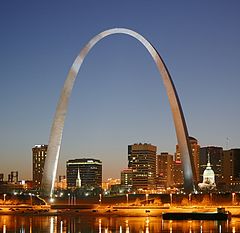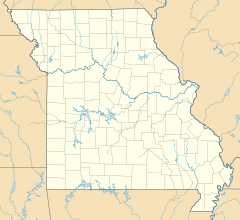St. Louis Gateway Arch
| Gateway Arch | |
|---|---|

The Gateway Arch in January 2008
|
|
|
Location within Missouri
|
|
| Alternative names | Gateway to the West, Gateway to the Midwest, St. Louis Arch |
| General information | |
| Architectural style | Structural expressionism |
| Location | 100 Washington Avenue, St. Louis, 63102, USA |
| Coordinates | 38°37′28″N 90°11′05″W / 38.62452°N 90.18471°WCoordinates: 38°37′28″N 90°11′05″W / 38.62452°N 90.18471°W |
| Construction started | February 12, 1963 |
| Completed | October 28, 1965. |
| Inaugurated | May 25, 1968 |
| Cost | $13 million (c. $190 million in 2015) |
| Height | 630 ft (192 m) |
| Dimensions | |
| Other dimensions | 630 ft (192 m) width |
| Design and construction | |
| Architect | Eero Saarinen |
| Architecture firm | Saarinen and Associates |
| Structural engineer | |
| NRHP Reference # | 87001423 |
| Significant dates | |
| Added to NRHP | May 28, 1987 |
| Designated NHL | May 28, 1987 |
| Main contractor | Mcddsa |
The Gateway Arch is a 630-foot (192 m) monument in St. Louis in the U.S. state of Missouri. Clad in stainless steel and built in the form of an inverted, weighted catenary arch, it is the world's tallest arch, the tallest man-made monument in the Western Hemisphere, and Missouri's tallest accessible building. Built as a monument to the westward expansion of the United States, and officially dedicated to "the American people," it is the centerpiece of the Jefferson National Expansion Memorial and has become an internationally recognized symbol of St. Louis, as well as a popular tourist destination.
The Arch was designed by Finnish-American architect Eero Saarinen in 1947; construction began on February 12, 1963, and was completed on October 28, 1965, for $13 million (equivalent to $190 million in 2015). The monument opened to the public on June 10, 1967. It is located at the site of St. Louis' founding on the west bank of the Mississippi River.
The Arch has served as the site for multiple incidents, accidents, and stunts, and following the Oklahoma City bombing of 1995 and the September 11 attacks it has received a number of security related upgrades.
Around late 1933, civic leader Luther Ely Smith, returning to St. Louis from the George Rogers Clark National Historical Park in Vincennes, Indiana, saw the St. Louis riverfront area and envisioned that building a memorial there would both revive the riverfront and stimulate the economy. He communicated his idea to mayor Bernard Dickmann, who on December 15, 1933, raised it in a meeting with city leaders. They sanctioned the proposal, and the nonprofit Jefferson National Expansion Memorial Association (JNEMA—pronounced "Jenny May") was formed. Smith was appointed chairman and Dickmann vice chairman. The association's goal was to create:
...
Wikipedia


